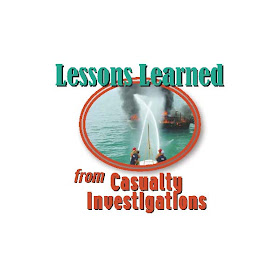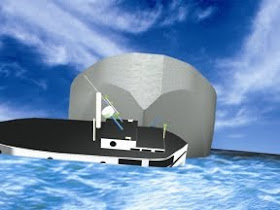
Excerpt from U.S. Coast Guard “
Proceedings of the Marine Safety & Security Council” magazine by Ms. Betty Lynn Sprinkle, special correspondent to Proceedings.
Lessons learned from USCG casualty reports are regularly featured in Proceedings of the Marine Safety & Security Council magazine. These articles explore marine incidents and the causal factors, outline the subsequent U.S. Coast Guard marine casualty investigations, and describe the lessons learned as a result.
It is important to note that lives were lost in some of the marine casualties we present. Out of respect for the deceased, their families, and surviving crewmembers, we do not mention the name of any person involved.
On December 11, 1998, the fishing vessel
Linda E, with three crewmembers, set out of Port Washington, Wis., to retrieve and set gill nets. Ordinarily, the vessel would have returned by 3:00 p.m. At 8:00 p.m. the Coast Guard was notified that the vessel was overdue.
The MysteryThe Coast Guard immediately initiated a search that ultimately covered 3,000 square miles of Lake Michigan. Searchers found no sign of the vessel, pollution, or debris. The last contact with the vessel was at 9:45 the morning of the 11
th, when a representative of the owners talked to a crewmember on a cell phone.
Typical of Great Lakes commercial fishing boats, the vessel was fully enclosed. A main deck ran its length and a raised platform was at the wheelhouse. The superstructure was fitted with portholes along the port and starboard side of the main superstructure and in all directions in the wheelhouse. The portholes were the only means of seeing out of the wheelhouse.
Four sliding metal doors—one aft, one amidships on the port side, and two forward—were opened for the crew to work the gill nets. The forward doors were used to retrieve nets, and the stern door was used to set nets.
The InvestigationThe Coast Guard looked at commercial vessels that may have been in that portion of Lake Michigan, and investigators interviewed the crews of several.
The U.S. Coast Guard Marine Safety Center (MSC) determined that the missing vessel met stability, severe wind, and rolling criteria. The MSC also determined that, even if the vessel had its bilges flooded and had accumulated ice upon its superstructure, it still would have substantial positive stability. The weather conditions did not contribute to ice accumulation, and no vessel in the area reported icing on that day.
Because fishing vessels like this one have no longitudinal watertight subdivisions, any breach of the watertight envelope would allow the vessel to sink. MSC calculations indicated that flooding through an opening the size of the sliding doors would cause the vessel to sink within seconds, while flooding through an opening of 2.5 inches in diameter, such as that from a failed fitting, would take over an hour to sink the vessel.
Initial ConclusionsThe
Linda E was presumed to have sunk off Port Washington. Three crewmen were missing and presumed dead. The lack of a distress call and fact that no survival equipment was located indicated that the vessel sank quickly. Weather and sea state did not appear to be factors in this casualty.
Based on information gained at the last contact with the crew, it was not likely that the vessel was overloaded or suffered from inadequate stability. However, if the
Linda E had carried an electronic position-indicating radio beacon, the Coast Guard might have been able to condense the search area.
For 18 months, the U.S. Coast Guard Marine Safety Office Milwaukee monitored local commercial salvors’ efforts to locate the vessel. Despite these efforts, the location of the vessel remained unknown until June 18, 2000, when the USS
Defender, a Navy minesweeper performing an underwater search, located it 260 feet below the surface.
In
Part II, we will explore what happened to the
Linda E.
For more information:Full article is available at
www.uscg.mil/proceedings. Click on “archives” and “2006 Volume 63, Number 2" (Summer 2006).
Subscribe online at
http://www.uscg.mil/proceedings/subscribe.asp.
Direct requests for print copies of this edition to:
HQS-DG-NMCProceedings@uscg.mil.
 Excerpt from U.S. Coast Guard “Proceedings of the Marine Safety & Security Council” magazine. Click here for Part I, Part II, and Part III.
Excerpt from U.S. Coast Guard “Proceedings of the Marine Safety & Security Council” magazine. Click here for Part I, Part II, and Part III.

 The Incident
The Incident



 In the picture at left, the U.S. Coast Guard Cutter Boutwell transfers custody of a fishing vessel to the Chinese Fisheries Law Enforcement Command.
In the picture at left, the U.S. Coast Guard Cutter Boutwell transfers custody of a fishing vessel to the Chinese Fisheries Law Enforcement Command.